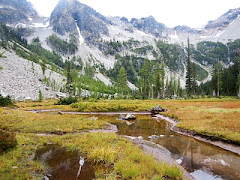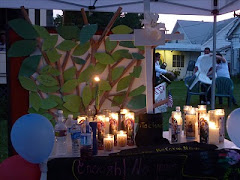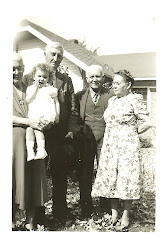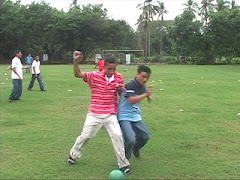FIRST LINES
And let us acknowledge the power
of this day's holiness,
for it is full of awe and dread
Un'taneh Tokef
First words with the first train out of town
before 5 am leaving New Ross. Fill
the child's pipe with tobacco
from Indians in the child's story.
Another translation calls your name
Sourdock-With-Tender-Leaves, like spinach,
grown-up's food in springtime. In full summer,
gone to seed, its flowers dried
and sperm-tasseled, dark along
highways of memory, its coffee-
colored reds and browns
could be chance-carried in cuffs
of men's pant legs on boats from Europe.
You are from here, where a child sits
dreaming out back, sending smoke
signals from a toy pipe.
Jim Bodeen
14 July 2010
QUESTIONABLE MEASURES
--for Arvin
Beyond nuisances
all plants have endearing qualities--
Agriculture, something man invented,
either moving or plowing,
throws things out of balance
Locust blossoms are out of this world
The black locust is a nuisance
Problems survive as a defense
Animals learn hard ways
learning the hard way
Even mosquitoes must be considered
advocating for bats, purple martins and frogs
to eat insects
13 July 2010
New Ross, Indiana
WALKING ORIENTATION AMONG LIGHTNING BUGS, BIRDSONG,
HOLLYHOCKS, LISTENING TO ARVIN BROKAW, CARETAKER
We planted all this, Mary and I.
We said, Jim and Karen won't recognize the growth.
These six acres make a world.
The Sycamore, the English Walnut.
Mulberries are weeds to some people.
Not here. Walk with me.
That White Ash came up in the fence row.
We've had 24 days with no rain,
but the corn's still growing. It's tasseling.
Monarch Butterflies need that Milkweed.
Corn won't allow milkweed.
Our neighbors, some say we like weeds.
OK. The Canada Thistle is one we don't care for.
We pull it. A large plant can produce 5000 seeds.
We don't use any poison.
I pull thistles, try to starve their root system.
Here is the Black Locust Forest.
I planted these by hand in 1981.
We haven't been that happy with them.
They were recommended for firewood.
Their bark is toxic to animals,
and when we kept cattle we lost a cow
who chewed on that bark.
Be careful of the Poison Ivy.
That's Bergament, a wild flower.
That's a red-wing blackbird.
We've counted 60 different birds.
Inderdependency is what we're after.
That's what the Monarch Butterfly needs.
Do you know the Bittersweet?
It was nearly extinct because of people
cleaning out fence rows. Mary and I prize
our Bittersweet, along with this fence row.
Berries in clusters in fall.
Country people value them as decorative.
We don't eat this garlic anymore.
I enjoy the life cycles.
A man helped me move that Tulip Poplar
last fall. It's a favorite of mine.
You can help me water it.
We'll pump water and carry buckets together.
Jim Bodeen
July 14, 2005
ON THE PORCH TALKING WITH ARVIN
AFTER RETURNING FROM PARKE COUNTY--
BIRD FECES, SEEDS, AND TREE ROOTS*
"The seeds lodge against fences, and in a neglected garden
more than enough elms spring up thus to set before the house."
--Henry David Thoreau, Faith in a Seed
"What you've done feels good to me. It makes clear the experience of the Irish and ties that in to state bioterrorism as it's practiced today -- both the high-tech developments of genetic engineering and the fact that famine is political."
--Jody Aliesan, email response to a question about the Irish famine
"Getting rid of fence rows
is what nearl caused the Bob White to disappear.
Do you know the Bob White?" Arvin asks.
"Are you familiar with Pheasants Forever?
Bob White are quail indigenous to North America.
The Ring Neck is from China.
Grasses, wild flowers. Diversity.
Bird feces is the critical link.
When settlers moved from Blue Ridge
into the Ohio Valley, they cut the forests.
They build houses and fences.
"Since diversity has occurred,
why would you want it do disappear?
I like seeds for their relative imperishability.
And they're disappearing!"
Livestock are the original grasses.
A new order of weed and grasses
could be traced in manure-born seeds
heading west. Small birds appeared.
"Worthiness of seeds--their flavor,
and nutrition is unspoken for.
My six acres speak for seeds and trees."
A complex of related things took place:
Cattle grazed in the pasture
dropping their manure.
They sidled up to fence rows.
Weeds and grasses grew
in their protection,
protecting fields from erosion.
"Arvin," I say, listen to the end of this note
from my friend, Jody: 'P.S. I just finished reading
a piece about biopharming and bioweapons.
It's a simple and ancient axiom:
if you control the seeds,
you control the food supply,
and if you control the food supply,
you control the people.'"
"I suppose that's true," Arvin says.
"There's a couple in Decorah, Iowa
involved in seed-saving. This couple
in Decorah will exchange seeds with you,
but they want to know what it is you've learned.
One of them said, 'I want my bread
to be bread that will mold.'"
My friend is Irish-American, Arvin.
She says, "Learn what happened
to the Irish under British rule.
Serfs on their own land
left with one species of potato
originally grown for animal feed.
When the blight came,
four years in a row, the Irish starved
while growing food for England."
Fence weeds trapped nutrient.
Fences became stalking platforms for birds
who fed on wild berries, shitting
and waiting for insects. Everything
grew in a fertilized fence row!
Cedars and chery trees!
Arvin asks, "Do you know Thoreau's Faith in a Seed?
It's on a shelf in the house. Thoreau said,
'Convince me that you have a seed there,
and I am prepared to expect wonders.'"
Fence, weeds, trees, and birds.
All interacting, each one protecting the other.
They send the invitation for others.
Squirrels and chipmunks.
Dogwood and persimmon.
"I know this," Arvin says,
"Bittersweet will not grow on a wire.
It cannot grow on a metal fence.
Quail eat ticks, and quail aren't around.
I've had a plague of ticks for 25 years."
At this point the fence row is 25-years old.
It protects the climate around the field.
It makes its own weather, changing the wind.
At maturity fence row country
becomes settled rural landscape.
"The Japanese Beetle is not my friend," Arvin says.
You've seen it stripping the leaves of trees and flowers.
Others use poison. I can't do that.
I've worked too hard to attract these birds.
All I can do each evening is brush
the ones I can reach into a pan of soapy water."
Fence rows and lanes stand against bulldozers now.
Maybe our best protection against erosion is at risk.
Jody says hedge rows go back
more than 5000 years in Ireland.
Traces excavated under bogs in County Mayo.
Arvin's wife, Mary Ellen, remembers
collecting dried Milkweed Pods
as a child during WWII. "They used them
for life preservers. "Do you know the Persimmon?"
Arvin asks. "Persimmon Trees grew
on Mary's side of Indiana, but not on mine.
Go ask the birds. They know."
We look at each other and look away.
Arvin's looking into my notebook,
and I'm looking into his trees.
Jody says we're reaching for each other
across space and time. Arvin gives
the last word to Lewis Carroll:
"'Don't just do something, stand there.'"
Jim Bodeen
New Ross, Indiana--Vancover, B.C.--Yakima, Washington
July 14-21, 2005
*Arvin Brokaw lives and farms in New Ross, Indiana. He and his wife, Mary Ellen, are critical links to my wife's family and family story.
Dr. Gerald L. Smith, writes "The People and the Land" and can be reached online or through the University of the South, Sewanee, Tennessee. I have used and drawn from his narrative to provide an extended definition of fence rows to supplement and expand the practicing wisdom of Arvin Brokaw. Dr. Smith's narrative appears here in italics.
Jody Aliesan is my friend "who writes" in the poem.
Subscribe to:
Post Comments (Atom)










































































You keep the stories alive if nothing else, fight against elegy, fight to keep the story the living thing. You honor these people, the land, their work. All good coming this far. Like the bees, no one owns the stories, but their keepers are a gift of themselves. kjm
ReplyDeletemy first of many future visits to you and Karen's vision quest. incredible. vmt
ReplyDelete